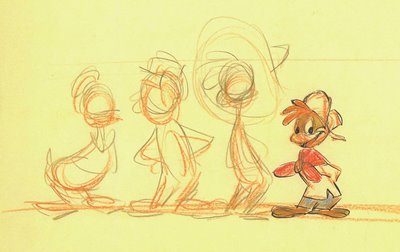from the collection of the Animation Guild: Warners animators and others locked out at Leon Schlesinger's studio(the supplier of Bugs Bunny, et al)circa 1941. To find out who's here, go read the post that accompanies this photo
After many years of passing like ships in the night I finally had a very interesting chat with our animation union business manager, Steve Hulett; we mainly talked about his friend, the late Niven Busch, a legendary writer and screenwriter he knew pretty well--and so should all of us, as Busch was a hell of a guy. Steve's been posting reminiscences and stories about him.
Which brings me to the subject of this post: Steve did me way too much honor the other day by referring to the Animation Guild's blog as a "poor man's Blackwing Diaries". He was being a bit (a lot!) facetious, I'm sure--but he meant that he was starting to post more of the fascinating, historical ephemera that I love to cram this space with too. Joking or not, it was a nice nod, and I really owe him one right back at him.
I'm overdue to mention their blog in any event(where he shares posting duties with our president, Kevin Koch--always a literate and thoughtful writer).
I demurred before as I figured theirs was likely of most interest to we daily toilers and our 401K concerns--but not so any longer(if it ever was): what Steve's been posting are some terrific historic materials--drawings by Ward Kimball, Milt Kahl--need I go on? Along with first-person tales of Disney feature animation from the early 1970s onward. This is great stuff, and the resulting comments often make even better reading.
Obvious to anyone who'd read more than one page of this blog of mine is my belief that if you're interested in animation, if you love cartoons and especially if you want to make them (assuming you don't already) you should also immerse yourself in as much of its history as you can.
Believe me: everything they say about it repeating itself, about those who ignore it being doomed to repeat it, and so on and so forth, is absolutely true. I remember every so often this or that pal at work bemoaning the fact that school doesn't prepare us for the real-life travails of the studio system(or any other kind of system). Well, there's a great way to gird yourself, and that's by finding out what those who went before us went through.
It wasn't all hijinks and laughs and parties, working on great films and a mutual admiration society...it was...well, pretty much just like it is now, absent a few obvious key players.
But those men and women have been supplanted by us, and we relive much of the struggles and drama--and fun--that they lived through. And they literally gave us our union, with it's attendant local benefits, pay scales and one of the very best health plans in the US(it really must be--the medical types keep telling me so whenever I flash my Motion Picture card at them).
So go and give The Animation Blog a perusal every couple of days at least, and check out the past, present and future of animation from two other perspectives.
























































